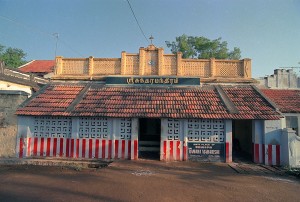Early Life
Arudra Darshanam, a festival that commemorates the manifestation of Lord Siva as Nataraja, the Lord of Cosmic Dance, was being celebrated with great ardor in the Bhuminatha temple in Tiruchuzhi, South India, on December 29, 1879. The decorated icon of Lord Siva was ceremoniously carried in procession through the streets during the day and late into the night. Just as the Deity re-entered the temple past midnight on December 30th at 1:00AM, the first cry of a baby boy was heard in a house adjacent to the temple. The fortunate parents were Sundaram Iyer and his wife Alagammal. The newborn child received the name Venkataraman and was later known as Bhagavan Sri Ramana Maharshi. As the child was being born, a lady with poor eye-sight exclaimed that the new born was enveloped in light.

Venkataraman’s early childhood was quite normal. He joined others of his age in fun and frolic. When Venkataraman was about six years old he made boats out of old legal papers belonging to his father and floated them in water. When his father reprimanded him, the boy left home. After a long search the priest of the temple found the boy hiding behind the statue of the Divine Mother. Even as a child he sought solace in the Divine Presence when troubled by the world.
Venkataraman completed elementary school in Tiruchuzhi and moved to Dindigul for further schooling. In February 1892, his father died and the family was broken up. Venkataraman and his elder brother went to live with their paternal uncle Subbier in Madurai, while the two younger children remained with the mother. Initially Venkataraman attended Scott’s Middle School and later joined American Mission High school.
The boy preferred playing sports with his friends over his schoolwork. He had an amazingly retentive memory which enabled him to repeat a lesson after reading it once. The only unusual thing about him in those days was his abnormally deep sleep. He slept so soundly that it was not easy to wake him up. Those who dared not challenge him physically during the day would come in the night, drag him out of bed and beat him up to their heart’s content while he was still asleep. All this would be news to him the next morning.
The youth first learned that Arunachala is a geographical location after asking a visiting relative, “Where are you coming from?” He replied, “From Arunachala.” The youth exclaimed with excitement, “What! From Arunachala! Where is that!” The relative, wondering at the boy’s ignorance, explained that Arunachala is the same as Tiruvannamalai. The sage refers to this incident in a hymn to Arunachala that he composed later on :
Ah! What a wonder! Arunachala stands as an insentient Hill. Its action is mysterious, past human understanding. From the age of innocence it had shone within my mind that Arunachala was something of surpassing grandeur, but even when I came to know through another that it was the same as Tiruvannamalai, I did not realise its meaning. When it drew me up to it, stilling my mind, and I came close, I saw it stand unmoving. “Eight Stanzas to Arunachala”
Sometime later he read for the first time the Periyapuranam, the life stories of the sixty-three saints. He was overwhelmed with ecstatic wonder that such love, faith, and divine fervor was possible. The tales of renunciation leading to Divine Union thrilled him with blissful gratitude and a wish to emulate the saints. From this time on a current of awareness began to awaken in him. As he said with his characteristic simplicity, “At first I thought it was some kind of fever, but I decided, if so it is a pleasant fever, so let it stay.”
